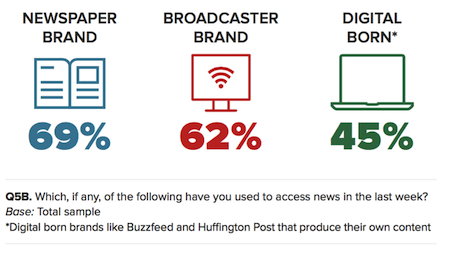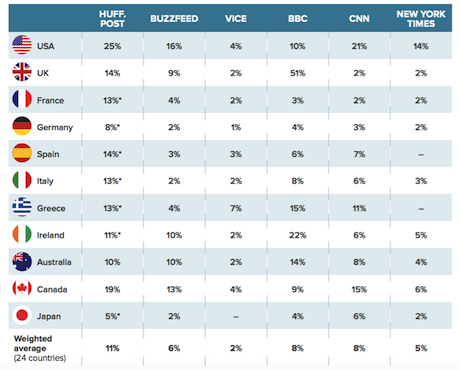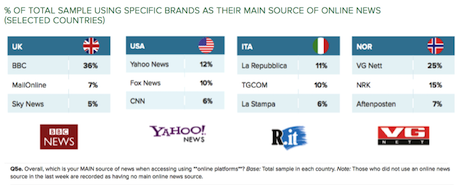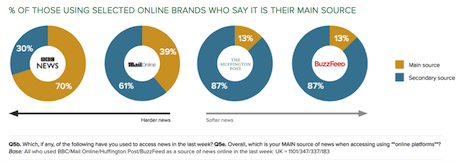The rise of distributed news consumption, along with a sharpening move to mobile and the widespread use of ad-blocking worldwide are three trends that combined are putting further severe pressure on the business models of both traditional publishers and new digital-born players, according to the Digital News Report published today (15 June) by the Reuters Institute for the Study of Journalism (RISJ).
But despite the rise of platforms and news aggregators, we find evidence that news brands are still hugely valued by audiences wherever their content is now consumed.
Across all of our 26 countries over two-thirds of our sample (69 per cent) access a newspaper brand online each week, with almost as many (62 per cent) accessing the online service of a broadcasting outlet. Almost half (45 per cent) access a digital born news brand each week, a number that has been increasing year on year.

In the digital born sector, the biggest growth in recent years has come from brands like the Huffington Post, BuzzFeed and Vice, which have global ambitions and have become masters of creating and distributing content for a mobile and social world.
In our data this year, we see the Huffington Post now as a major force in the majority of countries in which we conduct our survey. BuzzFeed has expanded its news operation in the UK, poaching Janine Gibson and other key staff from the Guardian and has increased its reach in both the UK (+4) and US (+5) over the last year.
Vice, on the other hand, is still relatively small in terms of reach, though it performs better with its youth-focused target market. When we weight this data by population size, we can see that in these countries at least, the Huffington Post reaches more people online (11 per cent) than the BBC (8 per cent) and CNN (8 per cent).

These impressive reach figures, however, hide a much more nuanced picture.
Some news brands – typically those that have been around a long time – are often seen as 'main' sources of news, whereas new players – even if they have a large reach – are thought of as secondary sources or ‘guilty pleasures’.
In the UK, it is the BBC that people turn to, while in Italy it is La Repubblica, in Norway VG Nett and in the United States it is Yahoo, Fox and CNN.

Taking the UK as an example, over a third of our entire sample said the BBC News website or app is their main source of news. That’s more than two-thirds (70 per cent) of those that use the BBC each week. By contrast, only a small percentage of BuzzFeed or Huffington Post readers (13 per cent) say these brands are their main news source.

Of course this is a complex picture where many digital-born brands, like Quartz, Politico, or Mediapart in France, are also in the business of providing serious news but to niche audiences.
We also found that some aggregator brands like Yahoo News in Japan, Yahoo in the United States, and Naver in Korea are relied on as a main source of news by a significant number of people. By carrying high-quality content where the source is not always noticed, it appears that, over time, these brands have managed to acquire their own credibility as a news source.
Individual brands clearly have different strengths and roles in the ecosystem – across types of news, stages of news story evolution, times of the day, and across different platforms.
Traditional brands tend to act as anchors or starting points, while native digital brands tend to act as supplementary sources or may help entertain in the downtime.
In our focus groups, we found brands such as MailOnline, the Huffington Post and BuzzFeed were seen as prominent sources for celebrity and entertainment stories. Established print and broadcast brands were more readily associated with harder news.

Partly as a result, we also found that readers of digital-born brands tend to be less loyal.
Main readers of BuzzFeed and the Huffington Post are much more likely to access it via social media or search than users of the BBC or other long-established news brands. BuzzFeed has said that 21 per cent of its traffic now comes from Snapchat and 27 per cent comes from native Facebook video.


For new brands, this is both good and bad. It means they can reach audiences for free on an unprecedented scale, but it also makes them uniquely vulnerable to changes in algorithms or advertising rules by leading platform players.
For all these reasons, it is highly likely that we will see digital-born players like BuzzFeed trying to make more of their destination websites and apps over the next few years.
Publishers like BuzzFeed, Huffington Post and Vice are developing more longer form content, more series and themes – recognising that loyalty and engagement will ultimately be critical if they are to build successful news brands for the long term.
The nature of our relationship with brands is changing. There are more brands to choose from along with an explosion of soft news that would previously not have been deemed fit to print.
Traditional brands have the advantage of credibility and heritage but new brands have a vibrancy and responsiveness that is often leading the way in innovation and new formats.Nic Newman, Reuters Institute for the Study of Journalism
More of us are accessing news across multiple platforms, through aggregators and social networks, but finding the signal in the noise can be time-consuming and confusing. Though all of this news brands can help consumers navigate this more complex landscape.
Traditional brands have the advantage of credibility and heritage but new brands have a vibrancy and responsiveness that is often leading the way in innovation and new formats.
Ultimately, in this battle for attention, only the strongest will survive; those who can deliver consistently with a strong audience focus, have a clear identity that matches the content proposition, and excel at distribution in a fast-changing environment.
Nic Newman is the lead author of the Reuters Institute Digital News report, published by Reuters Institute for the Study of Journalism (RISJ), based on a survey of 50,000 people in 26 countries. The full report is available here.
- Nic Newman will speak at our upcoming newsrewired digital journalism event in London on July 20, hosting a workshop about the latest trends in mobile news consumption. Find out more.
Free daily newsletter
If you like our news and feature articles, you can sign up to receive our free daily (Mon-Fri) email newsletter (mobile friendly).
Related articles
- 'I asked myself – why is he going public?': working with a Big Tobacco whistleblower
- RISJ Digital News Report 2024: User needs with Vogue and The Conversation
- RISJ Digital News Report 2024: Three essential points for your newsroom
- RISJ Digital News Report 2024: Five trends to watch in the UK
- 15 free sources of data on the media industry










